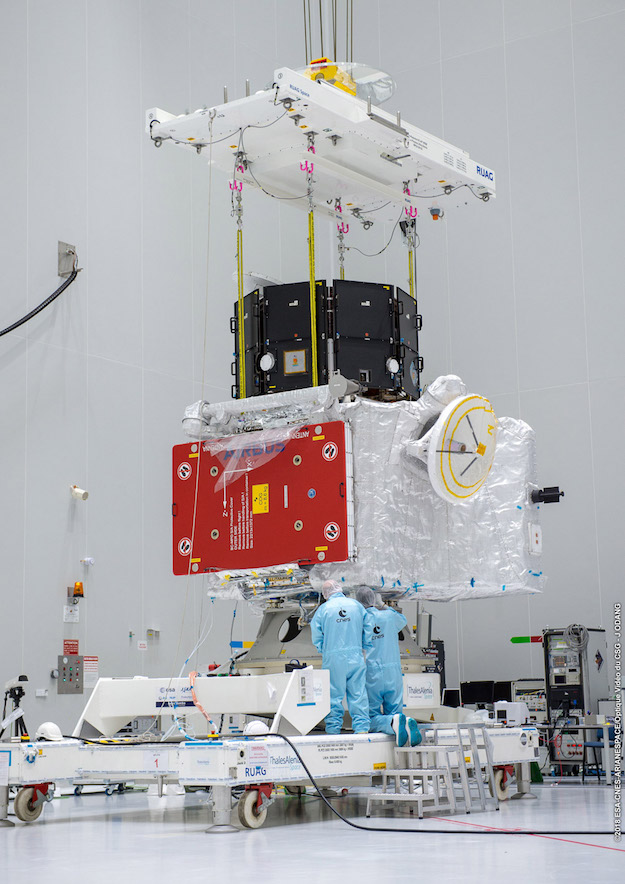Image: ESA/NASA
Don’t underestimate the planet Mercury. It may be tiny—at 3,000 miles in diameter, it’s outranked in size by Ganymede and Titan, which are moons of two of the Solar System’s gas giants. But small worlds can answer big questions, and Mercury remains by far the least explored of the solar system’s rocky planets.That’s why the European Space Agency (ESA) and Japan Aerospace Exploration Agency (JAXA) teamed up on the BepiColombo Mercury mission. Scheduled to launch on Friday night at 9:45 PM ET from French Guiana, Bepicolombo will be the third mission to visit the solar system’s innermost planet, after the Mariner 10 flybys in the 1970s, and NASA’s MESSENGER orbiter, which deliberately crashed on the planet in 2015. You can watch the launch live at the link below.BepiColombo, named after Mariner 10 scientist Giuseppe "Bepi" Colombo (1920-1984), contains three main components: The Mercury Planetary Orbiter (MPO) and Mercury Transfer Module (MTM), both built by ESA, and the Mercury Magnetospheric Orbiter (MIO) built by JAXA.For seven years, this trio will orbit the Sun as one unit, propelled both by the solar-electric MTM and several flybys of Earth, Venus, and Mercury. In December 2025, they will part ways when MTM drops off MPO and MIO in Mercury orbit, enabling the orbiters to observe the planet along different trajectories until at least 2027. Though it only took Mariner 10 147 days to travel from Earth to Mercury for a flyby, it takes seven years of gravity assists to achieve the exact right velocity and angle to be captured into orbit by Mercury’s weak gravity field. The MPO carries 11 instruments contributed by nations across Europe, from Finland’s Solar Intensity X-ray and particle Spectrometer (SIXS) to Russia’s Mercury Gamma-ray and Neutron Spectrometer (MGNS). It’s the generalist part of the mission, equipped to take a wide range of measurements that can corroborate past observations of Mercury’s structure, composition, and thin atmosphere, while also pursuing new questions.As an example of novel experiments, the orbiter’s Italian Spring Accelerometer (ISA) will be the first instrument to record the gravitational pull of the solar system’s planets on Mercury, in addition to the intense tidal forces of the Sun. This information will be used to test and refine Einstein’s theory of relativity, showcasing Mercury’s capacity to shed light on fundamental cosmic theories.
The MPO carries 11 instruments contributed by nations across Europe, from Finland’s Solar Intensity X-ray and particle Spectrometer (SIXS) to Russia’s Mercury Gamma-ray and Neutron Spectrometer (MGNS). It’s the generalist part of the mission, equipped to take a wide range of measurements that can corroborate past observations of Mercury’s structure, composition, and thin atmosphere, while also pursuing new questions.As an example of novel experiments, the orbiter’s Italian Spring Accelerometer (ISA) will be the first instrument to record the gravitational pull of the solar system’s planets on Mercury, in addition to the intense tidal forces of the Sun. This information will be used to test and refine Einstein’s theory of relativity, showcasing Mercury’s capacity to shed light on fundamental cosmic theories.
Advertisement

Advertisement
The MIO, meanwhile, is a specialist spacecraft focused on Mercury’s magnetic field, which is about 100 times weaker than Earth’s field. Venus and Mars are normally considered Earth’s sibling planets due to their proximities and similar sizes, but when it comes to magnetism, Mercury and Earth have the most in common.As the only terrestrial planet in the solar system with a global magnetic field besides Earth, Mercury is the place to look for clues about how planetary magnetism works, and why it occurs only around certain planets. MIO will study both the local field, and the broader interactions between Mercury’s magnetosphere and the solar wind.If all goes well with the launch on Friday evening, this next-generation Mercury mission will be on its way to visit perhaps the most underrated of all the solar system’s planets (though Uranus comes in a close second). Mercury may not inspire many dreams of human habitation, but it has captivated space nerds for over 3,000 years—and for good reason.Get six of our favorite Motherboard stories every day by signing up for our newsletter.Read More: The First Spacecraft To Orbit Mercury Will Die Today, Alone
